I think it's still a bit more complicated, look at your group delay plot. It's noticeably flat or close to zero all the way down to ~ 125 - 200 Hz. Yet your phase shows it's rotated at 200 Hz, indicating there is actual delay compared to the frequencies up higher.
So group delay isn't showing actual delay if I am interpreting this alright, remember (phase is =SomeMagicConstant*frequency).
Edit, Scrap the above, no magic constant here as far as I see. I just looked at the phase plot and GD plot again, and it would seem those two are in agreement at 200 Hz
Phase is rotated 90 degree at 200 Hz, that would be about 1.25 ms delay, looks about right.
I'd like to know what that last school of thought uses, both in room and speaker choices .
.
So group delay isn't showing actual delay if I am interpreting this alright, remember (phase is =SomeMagicConstant*frequency).
Edit, Scrap the above, no magic constant here as far as I see. I just looked at the phase plot and GD plot again, and it would seem those two are in agreement at 200 Hz
Phase is rotated 90 degree at 200 Hz, that would be about 1.25 ms delay, looks about right.
I'd like to know what that last school of thought uses, both in room and speaker choices
Last edited:
I think it's important to realize that there are two issues that arise due to the use of ports (which happen to be the reason they work in the first place):
-The first issue is phase shift which means the port sound is delayed 180 deg relative to the front side of the cone at the tuning freq.
-The second issue is that the polarity of the waveform, (which becomes the compression/rarefaction of the wavefront) is flipped at the tuning freq. The speaker has gone from suck to blow .
.
Moving a ported speaker around the room lets us trade between speaker/port delay, but does nothing to address the second issue.
Sealed mains trading off to a sub which is ported at 16hz probably would not present any real world problems. But ported mains and subs with higher tunings may...
-The first issue is phase shift which means the port sound is delayed 180 deg relative to the front side of the cone at the tuning freq.
-The second issue is that the polarity of the waveform, (which becomes the compression/rarefaction of the wavefront) is flipped at the tuning freq. The speaker has gone from suck to blow
Moving a ported speaker around the room lets us trade between speaker/port delay, but does nothing to address the second issue.
Sealed mains trading off to a sub which is ported at 16hz probably would not present any real world problems. But ported mains and subs with higher tunings may...
Last edited:
I agree with the above. I would seal off the mains and let the subs fill in the SPL needed there. Might even want to help out the mains SPL with processing like DRC can provide. With that I mean a little boost on the low end of the now sealed main woofers.
That way you could limit the amount of group delay at 40/50 Hz.
That way you could limit the amount of group delay at 40/50 Hz.
Last edited:

This time, I went all out to minimize GD to below 40hz (it doesnt start its rapid climb till about 37.5hz where I measure 13.3ms). Before, FR had always had the priority. This time, I was willing to sacrifice smoothness and magnitude.
Got a tell ya, this is the tightest ive ever heard my system. By comparison, there was more bass before, but now the kick drums and bass ripple through me in a much more defined way. Its like the direct wave was muddied up before. The difference can better be described in what i feel, rather than what I hear.
What I did was reduce overlap between the mains and the subs. Better defined and segregated what the subs were doing as well. Limited the big sub to only the extreme lows.
For comparison, with all channels driven, GD was 15.6ms at 40hz before, now its 11.2ms. It was 21.7 at 40hz when I began this thread.

This shows how much magnitude I gave up.
Last edited:
Nice. My response is down 9db or so at 32hz but those notes still feel good to me because the timing is good. Pretty soon we're going to have to start weaning you from CD player to PC.
This is a good way to put it. While there is less bass, whats there is better defined and articulated.
Very interesting thread, this! 
The audibility of group delay came up. Something from the side lines that may or may not be of interest: unpublished (as far as I know) studies by a Swedish acoustician and loudspeaker designer says that between 10 and 1000 Hz, we can - with some margin - tolerate group delays of about 0.8 divided by the frequency (result is in seconds). If the group delay is shorter than that, we perceive no detrimental effects of GD. Be it non-tightness or slowness or however we may describe it.
One important exception is apparently the range of about 100-250 Hz (peak at around 150), where we are more sensitive and may detect much shorter delays. It is unclear to me what the limit may be in that range, however. The statement I've read from the same source is that some listeners may be more than 4 times more sensitive at 150, which maybe can be interpreted that a quarter the above limit can be detected and might be a good limit to strive for in that entire range.
The audibility of group delay came up. Something from the side lines that may or may not be of interest: unpublished (as far as I know) studies by a Swedish acoustician and loudspeaker designer says that between 10 and 1000 Hz, we can - with some margin - tolerate group delays of about 0.8 divided by the frequency (result is in seconds). If the group delay is shorter than that, we perceive no detrimental effects of GD. Be it non-tightness or slowness or however we may describe it.
One important exception is apparently the range of about 100-250 Hz (peak at around 150), where we are more sensitive and may detect much shorter delays. It is unclear to me what the limit may be in that range, however. The statement I've read from the same source is that some listeners may be more than 4 times more sensitive at 150, which maybe can be interpreted that a quarter the above limit can be detected and might be a good limit to strive for in that entire range.
Very interesting thread, this!
The audibility of group delay came up. Something from the side lines that may or may not be of interest: unpublished (as far as I know) studies by a Swedish acoustician and loudspeaker designer says that between 10 and 1000 Hz, we can - with some margin - tolerate group delays of about 0.8 divided by the frequency (result is in seconds). If the group delay is shorter than that, we perceive no detrimental effects of GD. Be it non-tightness or slowness or however we may describe it.
One important exception is apparently the range of about 100-250 Hz (peak at around 150), where we are more sensitive and may detect much shorter delays. It is unclear to me what the limit may be in that range, however. The statement I've read from the same source is that some listeners may be more than 4 times more sensitive at 150, which maybe can be interpreted that a quarter the above limit can be detected and might be a good limit to strive for in that entire range.
As an electric bass player (an instrument with a heavy concentration of energy in the 100-250hz range) having performed in many venues over the years, I can count on about 2 fingers the number of times my instrument sounded right (and it's not the ear plugs
Very interesting thread, this!
The audibility of group delay came up. Something from the side lines that may or may not be of interest: unpublished (as far as I know) studies by a Swedish acoustician and loudspeaker designer says that between 10 and 1000 Hz, we can - with some margin - tolerate group delays of about 0.8 divided by the frequency (result is in seconds). If the group delay is shorter than that, we perceive no detrimental effects of GD. Be it non-tightness or slowness or however we may describe it.
One important exception is apparently the range of about 100-250 Hz (peak at around 150), where we are more sensitive and may detect much shorter delays. It is unclear to me what the limit may be in that range, however. The statement I've read from the same source is that some listeners may be more than 4 times more sensitive at 150, which maybe can be interpreted that a quarter the above limit can be detected and might be a good limit to strive for in that entire range.
If I worked your formula correctly, 40hz would translate to 20ms. Since you used the word "tolerate", I dont have any issue with that claim.
Since January, I have seen my 40hz GD go from 60ms, to 22ms, to 16ms, to 11ms. At each juncture, the difference was noticeable. The first jump being the most noticeable (obviously).
GD is one of those issues, at least for me, that I didnt notice as an issue until it was removed. I thought the 60ms@40hz sounded good in fact. Additionally, when I moved it to 25ms, I almost missed the big "fat" nature of the bass.
A caveat. As has been pointed out by others, other aspects of my bass response changed along with the GD reduction. Magnitude and decay rates being among them. So I cant be completely sure everything I am subscribing to GD is in fact such. As it happens, at least in my room, as the GD has diminished, so has the decay rates (shorter) and a bit of amplitude. I suppose the three go hand in hand to some degree.
Last edited:
I thought GD of under 2ms is in audible to most ears. The closer you can get to that the better. Most guitar cabinets are open baffle (open back cabinets ) so would actually have very low group delay. However if bass reflex ported subs are used to reinforce the sound - 25ms or so GD is added to it.
Hi All,
FYI: My thinking and some examples of scrutinized Designs:
b
FYI: My thinking and some examples of scrutinized Designs:

b
Attachments
-
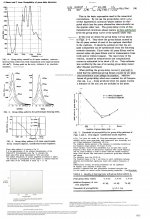 150Hz-Gldy.JPG712.1 KB · Views: 160
150Hz-Gldy.JPG712.1 KB · Views: 160 -
 Art's Keystone_2015_May23_18SW115_Scientific_MOD#4_21SW152.JPG812.3 KB · Views: 77
Art's Keystone_2015_May23_18SW115_Scientific_MOD#4_21SW152.JPG812.3 KB · Views: 77 -
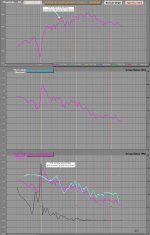 FR-min-Phase.JPG480.8 KB · Views: 78
FR-min-Phase.JPG480.8 KB · Views: 78 -
 gmad_Diff-PhaseShift-Dist.JPG883.8 KB · Views: 135
gmad_Diff-PhaseShift-Dist.JPG883.8 KB · Views: 135 -
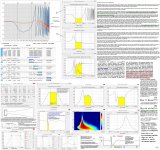 Tolerable-PhaseDist.JPG964.9 KB · Views: 135
Tolerable-PhaseDist.JPG964.9 KB · Views: 135 -
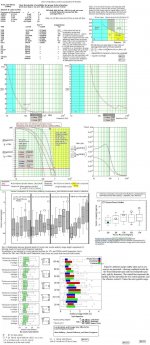 Gldy-extrapolation_and_Vertical Localisation-of-Woofers.JPG494.8 KB · Views: 137
Gldy-extrapolation_and_Vertical Localisation-of-Woofers.JPG494.8 KB · Views: 137 -
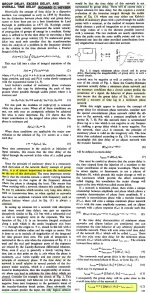 Overall-Time-Delay.JPG937.2 KB · Views: 138
Overall-Time-Delay.JPG937.2 KB · Views: 138
bjorno, I looked at those snippets, but I can't say it clearly shows a target or direction.
It wasn't free from some personal beliefs like having a dispersed FR giving a pleasant increase in depth of soundfield. to me it also means harmonics aren't heard at their true intention. Loss of impact/snap is another negative side effect.
Pre-ringing is real though with FIR filters and we'd have to keep an eye on that if you go that route. The low pass on the subs was huge! That's a steep filter that's recommended!
It wasn't free from some personal beliefs like having a dispersed FR giving a pleasant increase in depth of soundfield. to me it also means harmonics aren't heard at their true intention. Loss of impact/snap is another negative side effect.
Pre-ringing is real though with FIR filters and we'd have to keep an eye on that if you go that route. The low pass on the subs was huge! That's a steep filter that's recommended!
On my double 15, stock 2 ports open tune to 40hz.
It sounded much better stuffing one of the ports (changing tuning to maybe 28hz).
What ive seen is that excessive GD in port designs clears up once your 1 octave above the tuning frequency. So you have effectively moved that point from 80hz to 56hz or so.
The consequence is that you gain cone excursion. Therefore you lose power handling capacity and gain low frequency distortion at higher power levels.
There is always a trade off.
As an experiment, I compared measured GD with:
1) Mains stuffed
2) Subs stuffed
3) Mains and Sub stuffed
The "RED" graph is all ports open.



The oddity here (to me) is that stuffing the Mains & Sub didnt change the GD much at all until you get below 25hz. While stuffing the sub only made the most difference.
Granted, some additional tweaking would be needed in each case for optimization. But what I think I am seeing is that the mains are not really the cause of my remaining excess GD. The ported sub is another matter. But due to its 39hz (or so) 4th order XO point, its damage is limited to below this frequency.
1) Mains stuffed
2) Subs stuffed
3) Mains and Sub stuffed
The "RED" graph is all ports open.



The oddity here (to me) is that stuffing the Mains & Sub didnt change the GD much at all until you get below 25hz. While stuffing the sub only made the most difference.
Granted, some additional tweaking would be needed in each case for optimization. But what I think I am seeing is that the mains are not really the cause of my remaining excess GD. The ported sub is another matter. But due to its 39hz (or so) 4th order XO point, its damage is limited to below this frequency.
Last edited:
But due to its 39hz (or so) 4th order XO point, its damage is limited to below this frequency.
Is 4th order needed? You might buy yourself 5ms by switching to 2nd order XO.
Only if you think it should be (lol)...
Is it really a 4th order crossover? Think of it, the mains run full range, no filter on the bottom. The sub fill's in the lows with a fixed 4th order electrical if I remember correctly and you move the sub till sub and mains are in phase. You couldn't call that a 4th order crossover, could you? You're just trying to keep the subs from playing higher with that slope. 4th order would do that better than 2nd order.
Is it really a 4th order crossover? Think of it, the mains run full range, no filter on the bottom. The sub fill's in the lows with a fixed 4th order electrical if I remember correctly and you move the sub till sub and mains are in phase. You couldn't call that a 4th order crossover, could you? You're just trying to keep the subs from playing higher with that slope. 4th order would do that better than 2nd order.
Last edited:
Only if you think it should be (lol)...
Is it really a 4th order crossover? Think of it, the mains run full range, no filter on the bottom. The sub fill's in the lows with a fixed 4th order electrical if I remember correctly and you move till sub and mains are in phase. You couldn't call that a 4th order crossover, could you? You're just trying to keep the subs from playing higher with that slope. 4th order would do that better than 2nd order.

Here is my mains. No HPF applied. See the cliff? What order of magnitude does that look like? Actually, its not 4th, its about a 8th (48db/octave). I am using high Q PEQ filters in addition to the LR4 to simulate this slope.
No, I am not just trying to keep the sub from playing higher. I am trying to match the slope provided by the mains.
Additionally, the plate amp driving the sub has a built in XO. It can not be bypassed. I could turn up to its max XO setting of 180hz, but its pointless in reducing GD to have two crossover slopes applied to the same device. I tried, and it was worse.
Your and X's advice would be good advice for a main that rolls off slowly. Mine does not as you can see. And no XO from mains to sub is going to work right unless the slope curvatures resemble each other. If they dont, you will get unequal overlap and mismatched phase.
So trust me, given the mains response, this is the only way.
Last edited:
- Status
- This old topic is closed. If you want to reopen this topic, contact a moderator using the "Report Post" button.
- Home
- Loudspeakers
- Full Range
- Group Delay Questions and Analysis

